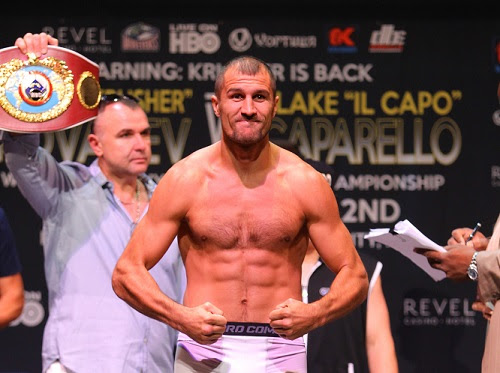By Norm Frauenheim-

Sergey Kovalev’s victory over Bernard Hopkins was one thing. His dominance was something else. After awhile, the benefit of hindsight will make Kovalev’s win look predictable. Nobody ever whips the clock, although Hopkins did it longer than anyone ever has. The shutout on the scorecards, however, was a stunning testament to a Kovalev skill set that had been unappreciated as much as it had been unexpected. It meant something else, too.
If there was ever a time and place to say that the ex-Soviet fighter has arrived, it was there, Saturday night in Atlantic City, with Kovalev’s thorough and patient triumph over an acknowledged master. There was an underlying assumption that the clever Hopkins would force Kovalev into an adjustment that would result in a critical mistake. There was a lot of talk about how Kovalev had never been beyond eight rounds. Translation: In the end, he would fight like a Russian. Didn’t happen, mostly because that stereotype no longer exists. For years, Soviet fighters were said to be tough, well-conditioned and powerful. But they were robotic and unable to think on their feet.
Like the Berlin Wall, that stereotype has fallen onto history’s scrapheap, gone for good. By going a full 12 rounds against Hopkins, Kovalev scored a symbolic stoppage of an assumption that might still linger had he knocked out a man just two months shy of his 50th birthday.
Kovalev proved himself to be more than a power puncher. He went the distance for a thorough, light-heavyweight victory over one the smartest guys ever in the ring. Fighters from the old Soviet Union aren’t thinkers? Think again.
Wladimir Klitschko has long been a thinking man’s fighter. For some reason, however, his smarts never captured
the U.S. imagination, perhaps because all of America’s best heavyweights are middle-linebackers and defensive ends these days. But Kovalev’s victory over Hopkins might awaken new found respect for Klitschko, who hopes to extend his eight-and-half-year-long heavyweight reign Saturday against Kubrat Pulev in Germany.
In the days since beating Hopkins, Kovalev has begun to show up in the pound-for-pound debate. P4P is an overrated exercise, to be sure. But it’s noteworthy this week, simply because of who else is already in many of the mythical ratings. In the ESPN edition, Kovalev is a new addition at No. 9. He’s one of three fighters from the old Soviet empire among the top 10. Middleweight Gennady Golovkin, of Kazakhstan, is No. 6. Klitschko, of the Ukraine is No. 8. Three fighters from old the Soviet bloc amount to more than from any other region in the world on a list hat includes two Americans, Floyd Mayweather Jr. at No. 1 and Timothy Bradley at No. 4.
There’s a theory that fighters from the discarded Soviet system are emerging because they now are forced to be creative. Dmitriy Salita, today a promoter and a former welterweight from the Ukraine, once told me that under the Soviet style every step in a fighter’s plan was marked down, rehearsed and memorized. Even the footwork was programmed, Salita said. But with the end of Soviet control, fighters, like entrepreneurs, had to hustle, which meant thinking for themselves. Hence, we have a Kovalev, a Golovkin, a Klistchko and others who one day might be included in the pound-for-pound debate. Featherweight Vasyl Lomachenko is a good possibility.
In 2014, it mean just one thing:
The collective — no pun intended — face of the fighter from the old Soviet Union should be Fighter of the Year.










